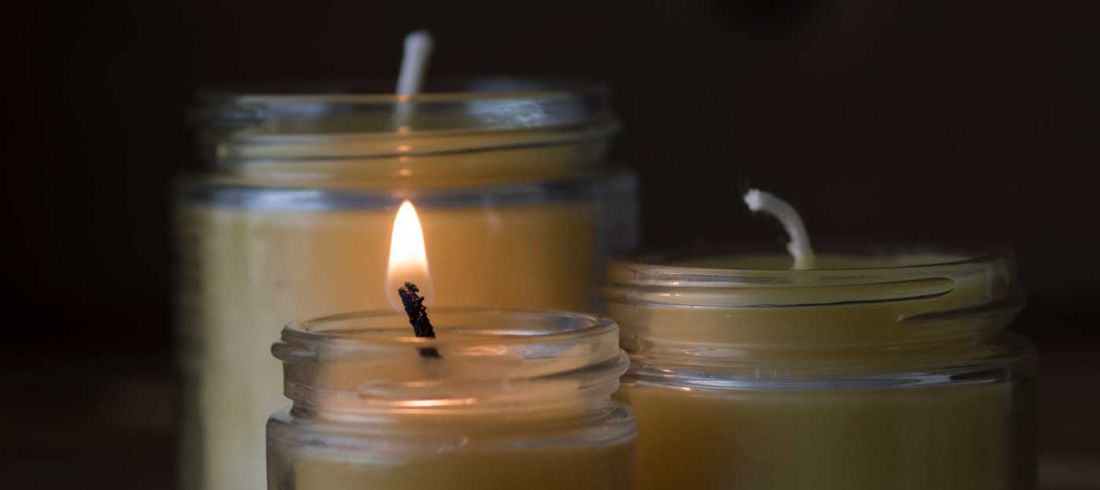Candles are delightful additions to any space, either to welcome in springy sunshine or chase off winter’s chilly darkness to our days. This flickering source of light adds natural ambience to a cozy room or a comforting feeling of warmth while you read a good book. Candles can be used to heat essential oils in a diffuser or be lit to set the mood during a special dinner with your sweetie.
Homemade candles are easy, fun, and affordable. Not only are they the perfect project for craft night, candles also make the sweetest holiday or birthday gifts for just about anyone. While making candles is mostly just melt and pour, you can also formulate a blend of essential oils to create a special scent.
Some things to consider before making your candles:

Beeswax:
Beeswax candles are a favorite among many for their naturally sweet, honey-like smell. It also burns slowly, which is something to take into consideration when purchasing wicks and containers. If using 100 percent beeswax (without fats like coconut oil, palm oil, or cocoa butter), it’s necessary to either buy wicks that are one size larger than recommended or purchase high temperature wicks in the correct size range. I recommend a mix of roughly 75 percent beeswax to 25 percent coconut oil.
Beeswax alone will tend to cave as it solidifies due to the outside wax cooling faster than the inside. Mixing the beeswax with coconut oil helps the candle solidify at a more even temperature and reduces the likelihood of the center collapsing, although it can still happen. For this reason, it’s good practice to leave space at the top of your jar, so you can cover up any caving in after the initial pour has cooled with a little more melted wax.
Vegan option:
For those who prefer not to use beeswax, carnauba wax is an option. Because it’s so hard and has such a high melting point (above 180 degrees Fahrenheit), it’s not a good idea to make a candle out of 100 percent carnauba wax. I experimented with diluting the carnauba wax with coconut oil and found the best solution is a 50/50 combination. This will lower the overall melting temperature, making it easier to get an aesthetically pleasing candle. Crafting with carnauba wax does require a bit of patience. I recommend using high-temperature wicks on all carnauba-based candles.
Making scented candles with organic essential oils:
From warming allspice or clove to earthy sandalwood or oak moss, naturally scented candles are a lovely way to incorporate aromatherapy into your space. If you’d like to use essential oils to scent your homemade candles, you’ll need to add more essential oil than you would for a typical body care or natural cleaning recipe. The amount you’ll want to use is similar to what you’d find in soap recipes, since much of the essential oil dissipates when mixed into the hot wax. I recommend using a 1/2 ounce to 1 ounce essential oil per 8 ounces of melted candle wax. I use roughly 200 drops of essential oil per 4 ounces of wax and find this to be a good ratio for strong aromas like lavender. However, for lighter smelling essential oils, you can try even more.
Containers and wicks:
You can use any container you like, but the size will determine the wick size. If you are using 100 percent beeswax with no fat added (such as coconut oil), you’ll want to use either a “high temperature wick” or buy a size larger than recommended to ensure an even burn. If you are using carnauba wax, you’ll want to use a high temperature wick, even when mixing with coconut oil. Buying the wrong size wick could result in an uneven burn that will create a pit down the center of your candle, rather than burning evenly from the top down.
Materials needed:
- metal pot with water
- Pyrex measuring cup (big enough to hold twice the amount of wax)
- candy thermometer (for watching flash points)
- wicks
- wick clips (optional)
- wick holders or pens/pencils/skewers for centering your wicks
- beeswax or carnauba wax
- butter/oil/fat of choice
- essential oils
- glass containers
Directions:
In a double boiler, heat the wax/fat blend until melted. Insert a candy thermometer in the center of the mixture. If you’re working with an open flame, don’t heat your wax too close to the flash point. For beeswax, this is 200 degrees Fahrenheit—the lowest flash point of most of the materials you’ll work with (coconut oil is near 350 degrees Fahrenheit). It’s important to look up flash points for materials when using an open flame heat source.
Once melted, dip the wick into the melted wax and press into the bottom of the empty candle container. The beeswax will solidify and hold your wick in place. This unfortunately doesn’t work for carnauba wax. In that case, secure the wick end with a piece of tape, or pour a bottom layer of wax to cover the wick end and allow to cool while you physically hold the wick in place.
Next, suspend the wick in the middle of the container with a pencil or skewer by wrapping the excess length of wick around the pencil and balancing the pencil horizontally across the jar opening.
While still on the heat source, add essential oils to the melted wax blend. Stir only once.
Immediately pour wax into containers, leaving roughly a 1/2 inch at the top.
Leave the Pyrex measuring cup in the heated water while your candles solidify.
Once the candles appear solid (30-60 minutes), you may notice that some have caved in slightly on top. You can now top off with the remaining wax, leaving just ¼ inch at the top.
Once completely cooled (or overnight), remove wick holders and snip wicks to ½ inch.
Light and enjoy!

